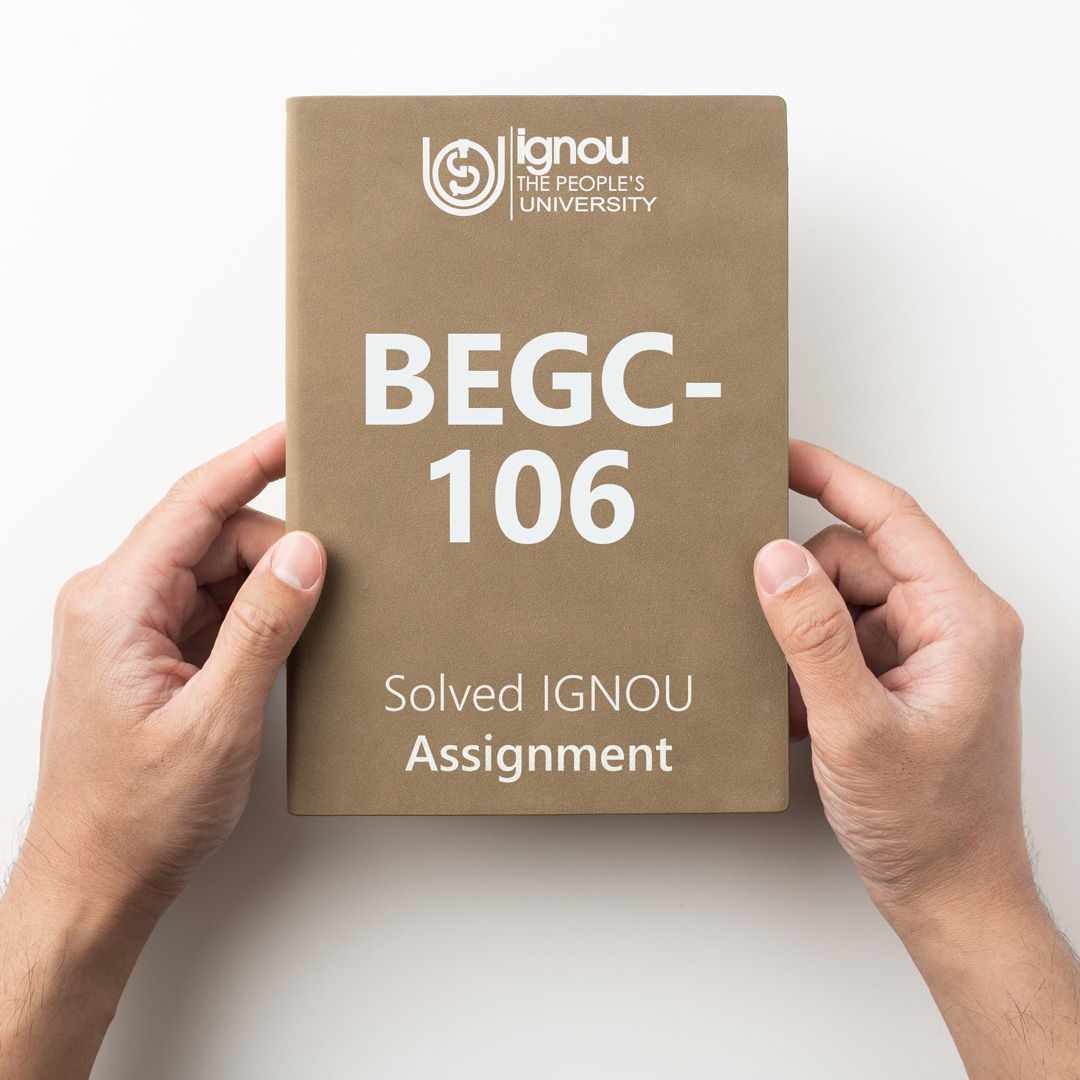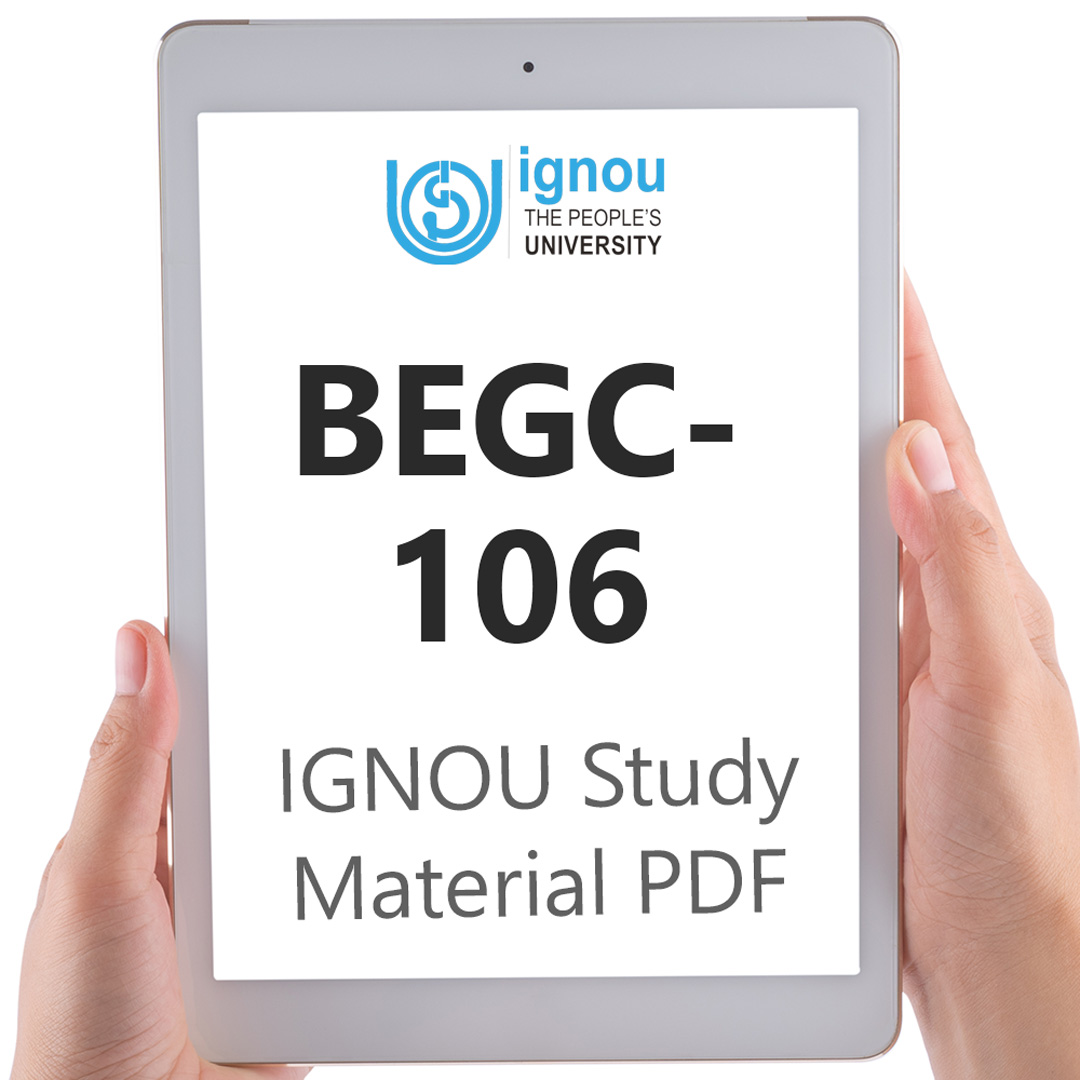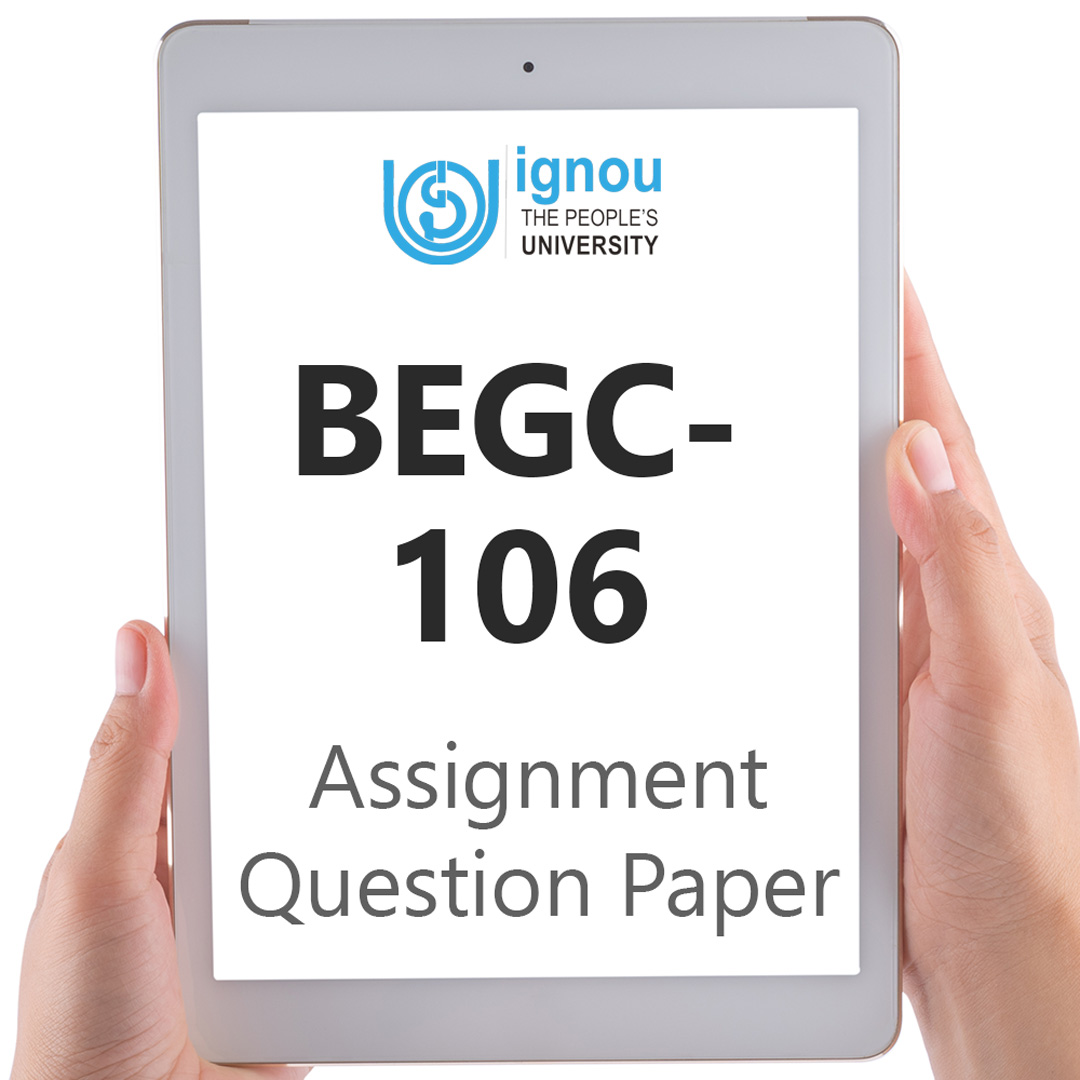If you are looking for BEGC-106 IGNOU Solved Assignment solution for the subject Popular Literature, you have come to the right place. BEGC-106 solution on this page applies to 2022-23 session students studying in BAEGH courses of IGNOU.
BEGC-106 Solved Assignment Solution by Gyaniversity
Assignment Code: BEGC-106/2022-23
Course Code: BEGC 106
Assignment Name: Popular Literature
Year: 2022-2023
Verification Status: Verified by Professor
Max. Marks: 100
Answer all questions.
Section A
Write short notes in about 100 words each: 4 × 5 = 20
Q1. (i) Digital Texts
Ans) The body of writing known as electronic literature is already extensive, and it is further broken down into genres like hypertext fiction, which is distinguished by linking structures, and interactive fiction, which has more pronounced game components and narrative features. The growth of a significant volume of fan fiction has also been aided by the internet's sharing economy. In order to discuss ideas and work together, fanfiction writers frequently use the internet to connect with one another and establish online groups. One such hugely famous online platform is Live Journal, where readers frequently adapt their favourite novels into various types of creative pieces and publish them online. Fan fiction blurs the line between author and reader since the text becomes a living, evolving thing that is continuously being changed and improved.
Q1. (ii) Young Adult Fiction
Ans) In general, young adult fiction (YA) is literature created for readers between the ages of 13 and 19 or even 21. The genre was created to fill the gap between fiction read by adults and literature written for youngsters under the age of 12 or 13. Young adult literature's themes and genres are related to the protagonist's age and background. Coming-of-age narratives are prevalent in young adult literature. Young Adult Fiction explores themes of adolescents coming to terms with themselves, their friendships, their romantic and sexual interests, overcoming personal problems, learning to take responsibility for their actions, getting into trouble, family life, self-identity, individuality, and sometimes even life-or-death situations, while putting a strong emphasis on real-life experiences and issues.
Q1. (iii) Hard Boiled Novels
Ans) The hard-boiled, noir fictions, or private eye novels written in post-World War II America by Dashiell Hammett and Raymond Chandler "suggests among other things: a solitary eye, and the (forbidden) pleasures associated with Freud's scopic drive; an on-the-job man's eye, like the frontier scout's or the cowboy's; an eye that trusts no other; an eye that's licenced to look; and even This genre was mostly created as a result of the mechanised industrialism of the early 20th century and the quick urbanisation that resulted from advances in electrical technology and the motion picture industry.
Q1. (iv) Digna Pattern
Ans) The Gond Digna pattern in the Bhimayana was employed by the illustrators to imply page breaks as graphic novels lack the customary page breaks. Originally, the Digna was used to create patterns on the walls and floors of Gond households and was regarded as lucky. The similar technique is employed in the Bhimayana to divide the pages because tubular shapes not only divide the pages but also become streets and pathways with moving cars, animals, and birds. Chandra notes that the Digna patterns, which have taken the place of the page margins in Bhimayana, may suggest that the Dalits, who were once marginalised, are now coming toward the centre.
Section B
Answer the following in about 350 words each: 4 X 2 = 80
Q1. Try and locate Young Adult Literature within Popular Literature.
Ans) Young adult fiction is a relatively new literary genre. To assist a more thorough understanding of young adult literature, it is crucial to research the numerous theories that have historically shaped how childhood is constructed. As much as they affect or produce them, traditionally dominating depictions of children are a symptom of prevalent notions about childhood.
Several studies have recently concentrated on the role that adults play in defining childhood. According to Diana Gittins, "childhood is more of an adult fabrication that, although appearing simple, actually conceals a myriad of contradicting memories, wants, and myths than it is a genuine or material condition of being." According to Kincaid, the child is a category that is becoming more and more void and may even be "a reservoir of cultural demands or dread not appropriately disposed of elsewhere." According to the phrase "the vacuity of the child," children "carry for us what we somehow cannot carry for ourselves." One can infer that the Victorian-era institutions and adults impose the myth of innocence as a value on the idea of the kid.
Beginning in the early 20th century, critics started to draw a distinction between childhood and adolescence. The Latin word adolescere, which means to develop or establish oneself, is where the word "adolescence" originates, claims Karen Coats. Earlier critics connected this time of life to erratic behaviour, mood swings, parental discord, etc. Literature written for this audience frequently captures the process of growing up and the tension between societal expectations and the quest to build one's own distinctive identity.
As an alternative, they indoctrinate certain social and cultural values while simultaneously providing an outlet for the imagination and wish fulfilment through fantasy. Many popular literary and social tales, such as the bildungsroman, place a lot of faith in the notion that children develop normally and will eventually mature into socially aware adults. Adolescence is viewed as a transitional stage during which kids undergo instruction geared toward preparing them for adulthood. Adolescence in this category eventually adopted the moniker "young adult," and it is now a mainstay of popular literature.
Q2. Comment on the relationship between the Lion and the Unicorn in Through the Looking Glass.
Ans) The lion and the unicorn are engaged in combat for the king's throne, the messenger informs the White King. A well-known nursery rhyme illustrates the hostility between the Lion and the Unicorn. The customary creatures employed in Britain's and Scotland's coats of arms in the 12th century, which speak of the competition between Britain and Scotland, are the lion and the unicorn.
There is a current reference in the lion and unicorn episode. John Tenniel, a political cartoonist known for his Punch magazine cartoons as a political satire, created the lion and the unicorn to parody two well-known politicians of his time, William Gladstone and Benjamin Disraeli. These animals are not just ordinary lion and unicorn; rather, they make a reference to the politics of Carroll's day. Tenniel made the unicorn resemble Disraeli while making the lion resemble Gladstone to illustrate the conflict between the liberal Whigs and the conservative Tories of the day. Throughout Queen Victoria's reign, these two politicians engaged in constant conflict with one another.
Even though Disraeli was a personal favourite of Queen Victoria, it was Gladstone who "beat the Unicorn all about the town" and served as the country's prime minister for a longer period of time. The Cake is a representation of the shared electoral mandate that led to the election of Gladstone, who followed Disraeli as prime minister and held the position for twelve years. The two political candidates are portrayed as the logical Gladstone and the crazy Unicorn, who both want a bigger electoral piece of the country's pie.
Ironically, Disraeli, the unicorn who is fake and is known for his idealistic ideas, deems Alice a "fantastic monster," which is a role reversal. The cake's difficulty in being cut also makes it a challenging exercise since, despite Alice's continuous slicing, the cake slices keep fusing together. The unicorn says that the cake must be handed around and then cut in the looking glass universe. The cake literally breaks into three pieces when it is passed around, symbolising the United Kingdom of Wales, Scotland, and England as well as the combined electoral mandate of the Britons.
Q3. Analyse Funny Boy as a bildungsroman.
Ans) The outstanding debut book Funny Kid by Shyam Selvadurai is a bildungsroman (a book about a character's moral and psychological development) about a young boy named Arjie, who comes to terms with his sexuality in the midst of Sri Lanka's political unrest. The journey toward adulthood and a child's sexual awakening is bittersweet. The inner conflict and self-doubt of a child regarding his identity and the realisation of his actual self are shown in this "coming of age" book. The author places attention on how people respond, labelling as "funny" something that seems unique to them.
This book is much more than just a sexuality storey. It transports us from the brilliance of childhood simplicity to the dimly lit world of adulthood. It resonates in Arjie's responses to this mysterious yet incomprehensible adult world. He would be forever changed by the depressingly disappointing breaking of expectations, 7-year-old Arjie losing his innocence, and reality shattering his love-comic universe. Through the eyes of a child, Selvadurai delicately explores the topics of gender relations, marriage, politics, and minority cultures. We see how things like meeting someone from a different community, acting and dressing "like a guy," and not being permitted to play the role of the bride and groom start making sense to him.
Selvadurai challenges the audience to consider the inherent hypocrisy at the very core of knowledge and cultural learning by choosing to tell the storey from the viewpoint of a young child. Arjie's blank slate mentality allows the author to demonstrate the absurdity of these pre-established rules. Additionally, he experiences suffocating when these norms are forced upon him. The storey explores a different societal issue in each chapter, letting the reader realise how unimportant these concerns are and how important it is to address them. It simultaneously encourages body positivity and helps readers come to terms with their own sexual identity. The struggle for identity that Arjie is going through personally and internally demonstrates the depravity of information about such crucial social concerns.
The work also emphasises how society shapes a person's identity through indoctrination. How it does not personally harm a person to fall in love with or marry someone from a different culture, yet it is nevertheless against the law since it could damage the family's reputation in society. Selvadurai challenges social conventions, which have over time merged with political power and are utilised to exacerbate social differences.
Q4. Examine the role and significance of the narrative voice in “The Ones Who Walk Away From Omelas.”
Ans) By leading the reader into the city and then encouraging them to contrast Omelas with their own moral cosmos, the narrator acts as a link between the audience's reality and that of Omelas. The storey of Omelas is, in the words of Khanna, "a neat epitome of 'utopia' as a discourse of indeterminacy," with its dialectical tensions of beautiful accomplishments, great parks, and public buildings and its underbelly being the home of a "secret sufferer"; the storey of the citizens who stay and accept the plight of the child as a given and the citizens who choose to walk away because they refuse to participate in the vision of such a It is possible to interpret this ambiguity and the narrator's self-reflexive voice as a postmodernist parable in which the narrative "foregrounds and fails to resolve typical generic tensions."
The paradoxical nature of the narrative voice helps us to understand the characteristics and duration of this wicked social contract. The narrator uses the highly explicit and visual depiction of this brutally imprisoned infant, "whose anguish is the condition upon which the entire happiness of the Utopia is predicated," to draw attention to the tensions and contradictions that are inherent in the utopian genre itself. The narrator's constant use of conditional verbs, the present tense, rhetorical inquiries, and the past tense shifts "make the reader aware of ambiguities and different views" found in utopian fiction. The narrator's impassioned and in-depth description of the glittering metropolis of Omelas is indecisive and filled with a sense of failure, which forces the readers to imagine and participate in the creation of this paradise.
The narrator's account of this child's miserable life contradicts the reader's affirmation of it. The narrator's tentative tone is swapped out for an authoritative one when describing the innocent victim's suffering. This raises questions about the genre's limitations as well as the overt adoption of the scapegoat system as the fundamental rules guiding Omelas. Readings from past and present socio-political literary imagination serve as the foundation for the fun-loving city's rituals and myths, which imply that our modern society—of which we are residents—is no different from Omelas in terms of its norms and laws.






